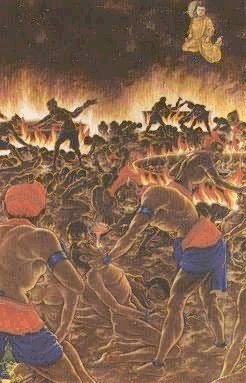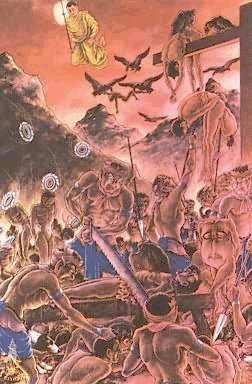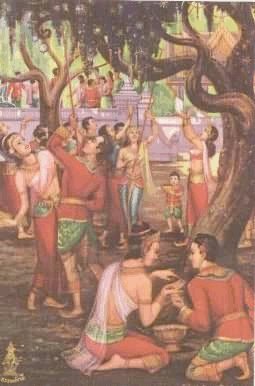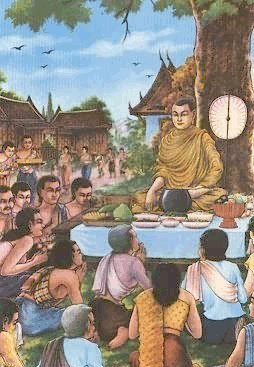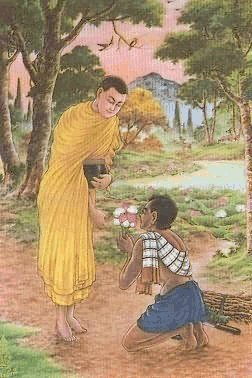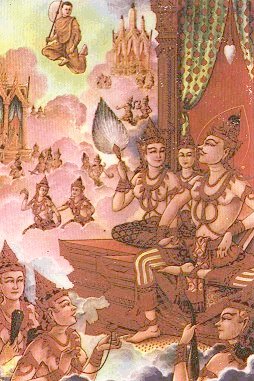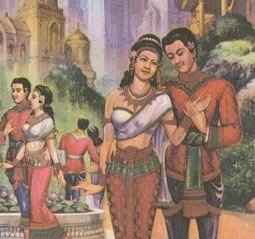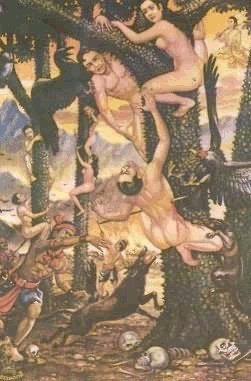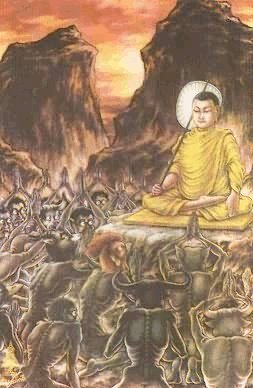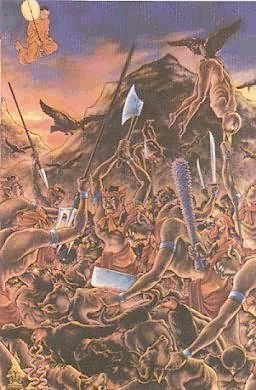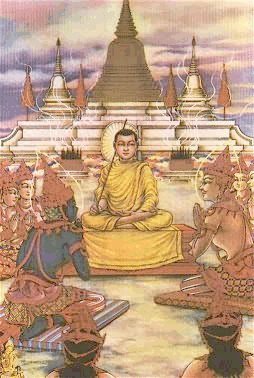Near-Death Experiences in Thailand
Discussion of case histories
Todd Murphy home email
Published in the Journal For Near-Death Studies, 2001
Murphy, Todd. “Near-death experiences in Thailand.”
Journal of Near-Death Studies 19, no. 3 (2001): 161-178.
CLICK HERE TO GO TO CASE HISTORY COLLECTION.

Spirituality & The Brain (Home Page)
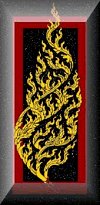
We will argue that the phenomenology of NDEs is not determined by a person’s culture, but rather reflects that person’s expectations of what death will be like. These expectations are most often, though not always, derived from a person’s culture. Culture-bound expectations (whether conscious or unconscious) about death are, in turn, most often, but not always, derived from it’s religious traditions. NDE phenomenology is both highly individualized, and at the same time shared by many people. Culture is universal, but so are deviations from it’s norms.
For several reasons, Thailand seemed to be a good place to test this idea. 1) The indigenous culture is still the dominant culture. Except for a very brief period during it’s occupation by the Japanese, Thailand has never been colonized. In many cases, traditions begun in it’s classical period continue up to the present. 2) Thailand’s religion is exceptionally uniform, with over 95% of it’s people being raised in the Thervadin Buddhist tradition. 3) Thai popular ideas about death are largely derived from a single source, a still untranslated text called The Book of Phra Malaya, which is the name of a medieval monk whose `visions’ of heaven and hell are described in it.
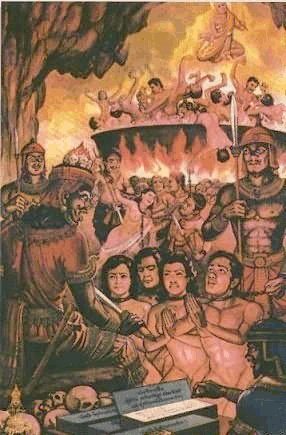
THE BOOK OF PHRA MALAYA
Judgment in the Hall Of Yama, Lord of the Dead.
The Book of Phra Malaya is the single most important source of Thai ideas and expectations about death and dying. It recounts the visions of heaven and hell experienced by a medieval monk during his meditation. It first describes his descent into hell. There, he witnessed the hall in which Yama, the Lord of the Dead, assigned the souls of the dead to their appropriate rebirths. There were several options for rebirth available. A person could be reborn as a human with any social status, with any degree of attractiveness, as any type of animal, into any one of fourteen hells, or into any one of nine heavens.
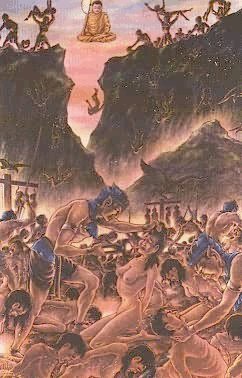
The Hell for liars
Phra Malaya then toured the hells, where he witnessed the various specific tortures inflicted on those who had committed specific various types of sins. After that, he visited a number of heavens. Both the heavens and the hells he saw bear a strong similarity to those described in two Buddhist classical commentaries, the Abhidhammatta Sangaha of Acariya Anuruddha, (12th century) and the Vissudhimagga of Buddhaghosa Acariya (14th century). These two texts were preceded by the Vimanatthu (one of the minor anthologies of the Pali Canon), and the Hindu scripture called the Siva Puranas (ch.5-27), both of which also contain similar descriptions of heaven and hell.
(Click image to view close-up)
The Hell For Alcoholics
(Click image to view close-up)
The Hell For Thieves
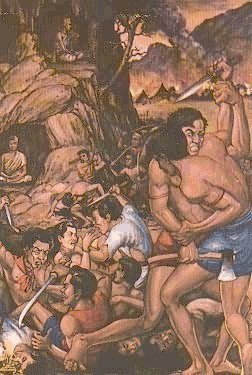
The Age Of Migasanni
Phra Malaya then saw two `future’ periods, the `age of Migasanni’, a sinful era dominated by violence, and the `time of Sri Ariya’, a heavenly future where, among other things, wish fulfilling trees will grow. These trees are said to produce whatever a person sitting under them wishes for, and grow jewels instead of fruit. The Sanskrit word for these trees is mani trees (mani means gem).
(Click image to view close-up)
In the Time of Sri Ariya.
The book of Phra Malaya seems to have no analog in the Judeo-Christian world. It’s as though Dante’s Divine Comedy were the sole source of western concepts about death and dying, and that its descriptions of heaven and hell were given the status of absolute truth. To continue the metaphor, imagine that Illustrations from Dante were hung in large numbers of churches to augment the usual religious instruction. Then imagine that motifs from Dante were used in comic books, cartoons, and government education campaigns. To complete the metaphor, imagine that the overwhelming majority of the public had simply never been exposed to competing ideas about death and dying. Reflecting on this hypothetical case might provide an idea of the situation in Thailand is like with respect to the ideas about death & dying found there.
Of course, there are differences between this scenario and the current Thai reality. In fact, there is an alternate set of teachings imported by the Chinese, but one which is quite similar, being also heavily influenced by Buddhist traditions. It also has multiple heavens and hells, and the lord of the underworld, Yama, appears in both traditions (cf. Williams, 1976). Further, Thailand’s religious makeup is not absolutely uniform. There is a small minority of Christians and Muslims, as well. Nevertheless, imagining a Christian community which had no ideas about the experience of death not found in Dante’s Divine Comedy gives a reasonably good metaphor for understanding thai concepts about death & dying in cultural context.
After contemplating this scenario, many NDE researchers would wonder if, in such a case, all NDEs might not manifest the same phenomenology as Dante’s Divine Comedy. Judging from the features of the case histories presented here, it does seem possible.
Making Merit
After the book of Phra Malaya, the next significant factor influencing Thai expectations of what it will be like to die come from beliefs associated with the custom of `Making Merit’ (Tham Boon). The concept of merit is closely akin to (but not identified with) positive karma. Merit is often spoken of as the source of good luck, as a religious practice, and as a kind of moral currency. Any compassionate or wise action is said to create merit, but one of the most powerful ways to make merit (open to the laity) is by donating food, money, or clothing to the Buddhist monks. The best way to make merit, outside of becoming a Monk, it is commonly believed, is to fund the construction of a Temple, or failing that, to fund the repair or restoration of a Temple. It is also commonly held that merit can be transferred. In the most common instance, Thai men ordain as Buddhist monks for a time before they get married, and pray that the merit they create be transferred to their mothers (Wells, 1975). The belief that `merit can be transferred is widespread. One contemporary Thai Buddhist author recently began his book (Jayamanggalo, 1996) by dedicating it to his teacher, offering the prayer that `any merit it may generate’ be dedicated to him. Both Buddhist scriptures and Phra Malaya spoke of making merit and dedicating it to the souls of those in hell to alleviate their suffering.
(Click image to view close-up)
Making Merit by Offering Food to A Monk
(Click image to view close-up)
Making Merit By Offering Flowers
Merit seems to grow over time, being augmented by karmically-positive actions (boon), but at the same time being decayed by sinful action (baap). The types of behaviors considered to be sinful are the usual types found in all important religions. Killing, gambling, theft, adultery, etc.. A caption found in a poster the author purchased in a Bangkok religious supply shop reads `Yama judges man and beast according to boon and baap’. The accompanying illustration shows Yama seated next to a scale whose arms are each hung with signs reading boon and baap. The implication is clear: merit and sin offset one another. One goes to heaven or hell according to the balance showed by the scales. How much merit a person has, is less important than whether or not it outweighs one’s burden of sin. The reviews of karma that occur in our collection of Thai NDEs are confined to examinations of single sins. In four cases (4, 6, 8, &10), this is done by accountants, reading from books. It’s almost as though the accountants were looking at only the balance due, while the Western panoramic Life Review covers the transactions. If the balance hangs heavily enough in a person’s favor, they can be reborn in the realms of the gods.
(Click image to view close-up)
The Heaven of Indra (Indraloka)
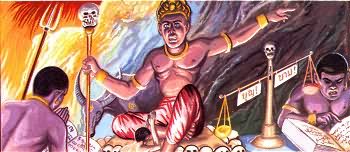
Yama sends a Yamatoot to collect a soul whose time has come. The illustration shows Yama’s accountant and the scales of Karma, with signs reading ‘sin’ and ‘merit.’ The Realm of Indra, King of The Gods.
(Click image to view close-up)
Marriage ‘works’ in the time of Sri Ariya.
Circumstances of rebirth, apparently, are subject to interpretation. Case #10 includes an account of a Yamatoot whose positive and negative karmas each created separate effects, whereas case #6 includes an account of the effect of a negative karma being canceled out by a positive one. Although most Thai Buddhists will agree that there are laws governing karma and its effects, there is neither agreement nor finality concerning the specific operations which are performed when these laws are brought into action. This lack of lucidity in the teachings allows a wide latitude in understanding how karma operates. We suggest that individual psychodynamics manifest in the specific operation of karma as it appears in any given Thai NDE. The most popular concept of karma in South East Asia is the formula “Do good; receive good. Do bad; Receive bad”. So long as this rule is preserved, an individual having an NDE in Southeast Asia can confabulate any `laws of karma’ to explicate their feelings about their life. If so, then the karmic review might be an example of a Life Review.
COMMENTS
One of the most interesting cases of the effects of karma manifesting in an NDE is in case #8, the case of `Kodien’. In this case, the Chinese merit-making practices Kodien (a Chinese-Thai) followed are rejected in favor of the Thai ones. Kodien was a Chinese person raised Thailand. His NDE seems to reveal that he was actually more drawn to the Thai ways of creating merit than to those of his own subculture. That an NDE of a person torn between two cultures should exhibit features of both suggests that it is not culture that determines NDE phenomenology, but rather that people’s NDEs reveal their expectations about what death will be like, even when these expectations are held subconsciously, or are influenced by more than one culture. Atwater (1994) has found that NDEs which manifest visions of the classical western hell are much more likely to occur in the Southeast part of the U.S., the so-called `Bible belt’, where the literal veracity of the Bible is often taken for granted. Christianity teaches that the only options are those of heaven and hell. For a person guided by this belief, we suggest, the choice of which they will enter happens according to the expectations created by their own feelings regarding their behaviors during their lives. Thai NDEs, with their frequent visions of hell, seem to confirm this interpretation.
The case of Kodien seems to rule out culture per se as the determinative factor in shaping NDE phenomenology. The fact that Thai (and Indian) NDEs do not follow the typical, Western, progression reflected by the Ring Scale seems to rule out the possibility that there is any such thing as an ideal or normal NDE scenario, except within a particular cultural context.
NDEs manifested within certain, special, groups have been studied that reveal typical variations. Pediatric NDEs (Morse, 1985), and those of pre-literate cultures, as well as those of India (Pasricha, 1986), Africa (Morse, 1992) have all been looked at, and patterns have been discerned in each group. However, the most common approach to discussing their typical features has been to compare them to the typical Western NDE; to the pattern shown in the Ring Scale. We would suggest that the near-constant comparisons with the most frequently reported types of NDEs tends to blind researchers to the features of NDEs which are absent in these NDEs. Tunnels are rare, if not absent. The panoramic Life Review appears to be absent. Instead, our collection shows people reviewing just a few karmically-significant incidents. Perhaps they symbolize behavioral tendencies, the results of which determine their rebirths. These incidents are read out to them from a book. There is no Being of Light in these Thai NDEs, although The Buddha does appear in a symbolic form, in case #6. Yama is present during this truncated Life Review, as is the Being of Light during Western life reviews, but Yama is anything but a being of light. In popular Thai depictions, he is shown as a wrathful being, and is most often remembered for his power to condemn one to hell. Some of the functions of Angels and guides are also filled by Yamatoots. They guide, lead tours of hell, and are even seen to grant requests made by the experient.
The most common first phase of Western NDEs is an Out-of-Body Experience (an OBE). An equally common first phase of Thai NDEs is a visitation by a messenger of some kind, most often a Yamatoot, one of the servants of Yama (all ten cases). The mythology of Yama and his servants was imported from India along with much of the Hindu/Vedic pantheon, and it can still be found in contemporary Indian NDEs (Pasricha, 1986). Phenomenologically, the appearance of a herald of death and an OBE could not be more disparate. Interestingly, OBEs in Thai NDEs tend to immediately precede meetings with Yamatoots. Their functions could be the same: to convey the news that one has died.
The OBE appears to rely on a specific neurological function. The neurosurgeon Wilder Penfield accidentally induced an OBE while stimulating the surface of one of his patient’s brain with electrodes (Penfield, 1955). The OBE occurs in many contexts outside of NDEs. It has also been reported in meditation experiences, fever delirium, shamanic `journeys’, temporal lobe epilepsy, dissasociative disorders, and it can even occur spontaneously. The autoscopic OBE (AOBE) is not subject to confabulation. During an AOBE, one still perceives the physical world, so it can not be validated in culture-specific ways. A person having an OBE will still perceive their surroundings. There are few reports, if any, of a person having an OBE while simultaneously seeing the being of light. Perhaps the recognition that one has died is easier if one experiences what one has been taught will occur at death. Thus, while an OBE may well be found in NDEs of all cultures, not all cultures recognize OBEs as a herald of death. Indeed, one of our cases (#10) a monk experiencing an NDE initially mistakes his NDE OBE for one appearing in his meditation. So, some cultures seem to have anthropomorphic harbingers that inform the person of their deaths independently of OBEs. Yamatoots, the Grim Reaper, and Angels all have appeared as harbingers of death.
It has been found (Horowtiz, 1970) that hallucinatory phenomena are facilitated by Altered States of Consciousness (ASCs). We might speculate that the ASC that occurs in conjunction with OBEs can also facilitate the confabulation of imagery which conveys that death has begun. If this were the case, then Yamatoots and OBEs each have the same function; to make the person aware that they are dead.
This notion might also help to explain why tunnels, common in Western NDEs, and having a known neurological basis (Blackmore, 1993) are also largely absent in Thai NDEs. Tunnels might symbolize moving from one ASC to another. Roads, or the act of walking, might symbolize the same thing in Thai and some Indian NDEs. Indeed, most of our collection features one or the other. One of our cases does feature a tunnel, (#10), but it does not occur at the beginning of the experience, as it most often would in Western NDEs.
The Light seems to be absent in Thai NDEs. So is the profound positive affect found in so many Western NDEs. The most common affect in our collection is negative. Unlike the negative affect in Western NDEs (cf. Greyson & Bush, 1992), that found in Thai NDEs (in all but case #11) has two recognizable causes. The first is fear of ‘going’. The second is horror and fear of hell. It is worth noting that although half of our collection include seeing hell (cases 2,6,7,9,10) and being forced to witness horrific tortures, not one includes the NDEer having been subjected to these torments themselves. The positive emotions that occur in our collection are those of pleasantness, comfort, a sense of beauty, happiness, and case #6 speaks of his feeling that those who he saw living in heaven were happy without mentioning his own feelings about being there. It’s also worth noting that we have one case in which someone saw only heaven, without also having seen hell. All these cases include both positive and negative affects. At least one similar case in the west has already been noted in the literature (Irwin, 1988).
Dead friends and relatives do appear, but in contrast to Western NDEs, these dead friends do not greet the dying person. Instead, in three of the four cases where the motif occurs in our collection of Thai NDEs, they seem to inform the dying person of the rules governing the afterlife (Cases #7, 8, 9).
The way Thai NDEers experience their resuscitations seems to have unique features. As in India, Thai NDEs (cases 1,2,4,6,& 8) often include the person being told that they are the wrong person, and being ordered back to normal consciousness. In contrast, Western NDEs often end with the person choosing to ‘go back’. Westerners might also find themselves spontaneously returning to their bodies, as also happens in Thai NDEs. Perhaps, where Westerners might choose to revive, Thais and Indians are forced to revive. The Thai and Indian cultures do not reward independence and individuality the way Westerners do. Instead, these cultures encourage dependence on one’s family, village, traditional religion etc. The idea that one has a choice about living or dying does not fit well in a culture where, traditionally, one cannot choose one’s spouse, work, religion, or where to live. Let your parents arrange your marriage. Follow in your father’s footsteps. Live by your parents, if not with them. Worship in the same place, and in the same way as the rest of your family. If the course of crucial life changes are imposed on someone, will they not be more likely to confabulate being forced to revive than choosing to revive? One case (# 8) ends with the NDEer being physically pushed into reviving.
Another theme in the return to life in Thai NDEs occur in cases 5,6, &11. In these three cases, the NDE ends with the person falling, and regaining consciousness as they hit the floor or ground.
Tentative conclusion
The conclusion we can offer is that, while the most common phenomenologies found in Western NDEs are either absent or rare in Thai NDEs, there are meaningful correlations that can be drawn. Typical phases appear in both, and with some typical ordering. The possibility arises that the same psychological processes are occurring in both types of NDEs, and that the only significant differences are in terms of their phenomenologies. It may that NDEs of all cultures share common patterns, but that these patterns are obscured by the many different confabulated phenomena through which they manifest. These confabulations, it appears, are highly individualized. The Thai cases support the idea that NDEs are postmortem confabulations occurring within specific cultural contexts.
(Click image to view close-up)
The Hell For Sexual Sinners.
(Click image to view close-up)
Hungry Ghosts Plead with Phra Malaya asking for him to petition their living relatives to make merit for them.
(Click image to view close-up)
The Hell for those Who Kill Animals.
(Click image to view close-up)
Malaya’s Sermon to The Gods.
Return Home
Bibliography & Footnotes
Atwater, P.M.H. “Beyond the light: What isn’t being said about the Near-Death Experience” Birch Lane Press, 1994
Blackmore, Susan J., Ph.D. “Near-Death Experiences in India: They have Tunnels Too”. Journal of Near-Death Studies, 1993, 11 (4), 205-217
Bodhi, Bhikku, (Ed.) “A Comprehensive Manual of Abhidhamma: The Abhidhammattha Sangaha of Acariya Anuruddha” Buddhist Publication society, 1993
Greyson, Bruce, & Evans Bush Nancy, “Distressing Near-Death Experiences” Psychiatry, 55, 1992, 95-110
Horowitz, M.J. & Adams, J.E., “Hallucinations on Brain Stimulation: Evidence for the revision of the Penfield Hypothesis”. Appeared in Kuep, (Ed.) “Origin and mechanism of hallucinations”. Plenum Press, 1970
Horner, I.B. “Vimanavatthu: Stories of the mansions.” Appeared in: The Minor Anthologies of the Pali canon, Pt. IV Pali Text Society, 1974.
Irwin, Harvey J., Ph.D., “The Devil in Heaven:, A Near-Death Experience with both Positive and Negative Facets”. Journal of Near-Death Studies, 1988, 7 (1), 38-43
Jayamanggalo, Phra Ajahn Mahasermchai, “The Heart of Dhammakaya Meditation”, Vision Art Press, Bangkok, 1997 (In Press)
Morse, Melvin, M.D. , Conner, Doug, & Tyler, Donald, M.D. “Near-Death Experiences in a Pediatric Population: A Preliminary Report” American Journal of Diseases of Children, 1985, 39, 595-600
Motilal Banarsidas, The Sive-Purana (no editor listed) Translated by the Motilal Banarsidas translation Board. Delhi, 1978
Nanamoli, Bhikku, (Transl.) “The Path of Purification: Vissudhimagga By Bhadantacariya Buddhaghosa”. Buddhist Publication Society, 1975
Osis, Karlis, & Haraldsson, & Erlendur, Ph.D., “At the Hour of Death”, Avon Publications, 1975
Pasricha, Saywant, Ph.D. & Stevenson, Ian, M.D. “Near-Death Experiences in India: A preliminary Report”. Journal of Nervous And Mental Disease, 1986, 174 (3) 165-170
Penfield, Wilder, Dr. “The Role of the Temporal Cortex in Certain Psychical Phenomena” Journal of Mental Science, 1955, July, 101, 451-465
Schorer, C.E., M.D. “Two Native American Near-Death Experiences” Omega 16 (2) 111-112
Wells, Kenneth E., “Thai Buddhism: It’s Rite And Activities”. Suriyabun Publishers, Bangkok, 1975
Williams, C.A.S. “Outlines of Chinese Symbolism & Art Motives” Dover Books, 1976
NOTE REGARDING ILLUSTRATIONS:
These are public domain illustrations, and may be distributed freely. In keeping with Thai religious traditions, we ask that they be distributed without charge, and that they be identified as Traditional Thai Buddhist Art wherever they are reproduced.
Acknowledgements:
The author wishes to thank Dr. Debhanom Muangman, Director of the Rangsit-Harvard Medical International Program, and Phra Gandhasarabhivamsa of the Tamaoh Temple in A. Muang, Lampang Province, for providing NDE accounts from their files, Ms. Sasikarn Santideja of the Thammasat University Languages Institute in Bangkok, Phra Mahanaradhip Kaewprasitidhi of Phra Pathom Chedi Temple in Nakhorn Pathom, and Maneewan Pike, a Thai national living in the United States, for their invaluable help in translating the accounts on which this article is based. He also thanks Bhikku Pannavaro of Bowoniwet Temple in Bangkok for his useful scholarly suggestions.

